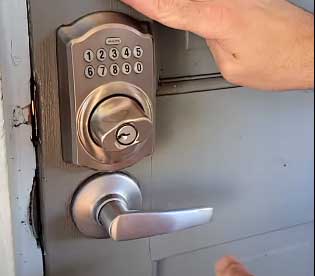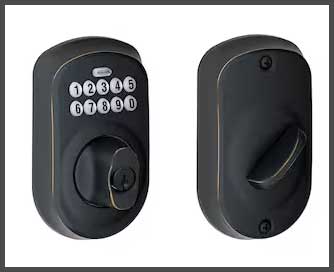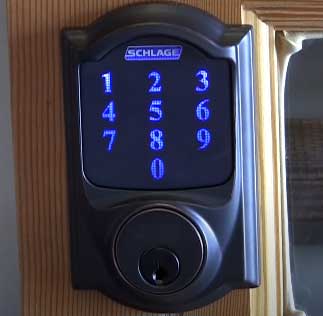Home security is top of mind for many homeowners these days. With smart home technology advancing rapidly, smart locks that you can control from your phone are becoming a popular option to upgrade home access control and security.
Two leading smart lock brands, Schlage and Yale, offer keyless touchscreen deadbolt locks with similar features but at different price points. This article will compare Schlage’s Camelot and Plymouth smart locks to help you choose the right one for your needs and budget.
A Brief Comparison Table
| Feature | Schlage Camelot | Schlage Plymouth |
| Price | $149-$179 | $229-$259 |
| Security Rating | ANSI Grade 2 | ANSI Grade 1 |
| Encryption | No | AES 128-bit |
| Access Code Capacity | 30 codes | 100 codes |
| Smart Home Compatibility | Alexa, Google Assistant, HomeKit | Alexa, HomeKit |
| Auto-Lock Settings | 30 sec, 60 sec, 2 min | Fully adjustable |
| Alerts and Notifications | Lock/unlock status | Lock/unlock status |
| Battery Options | 4 AA batteries | 4 AA batteries |
| Finish Options | 1 finish | 3 finishes |
| Exterior Housing | Plastic | Metal |
| Handle Type | Fixed thumbturn | Reversible levers |
| Installation | Simple surface mount | Simple surface mount |
| Rekeying | Yes, external rekey | Yes, external rekey |
Overview of Schlage Camelot and Plymouth
The Camelot and Plymouth are Schlage’s entry-level and mid-range keyless touchscreen deadbolt locks. They have a simple, classic design with an exterior touchscreen keypad and thumbturn.
Camelot is Schlage’s basic model with standard security features. It can store up to 30 access codes and provides a keyway for physical keys as a backup.
Plymouth has more advanced features with encrypted smart key security. It offers storage for 100 access codes and has a higher security grade certification (ANSI/BHMA Grade 1) compared to the Camelot.
Both locks work with the Schlage Home app to control access codes and monitor activity. They run on 4 AA batteries and have adjustable backset sizes to fit standard residential doors.
Schlage Camelot Features

- Keyless touchscreen with 4-9 digit codes
- Stores 30 access codes
- Built-in alarm technology
- HomeKit integration (Apple)
- Works with Alexa, Google Assistant
- Keyway for physical keys
- ANSI Grade 2 certified
Schlage Plymouth Features
- Keyless touchscreen with 4-8 digit codes
- Stores 100 access codes
- Encrypted smart key security
- Built-in alarm technology
- HomeKit and Alexa integration
- Higher ANSI Grade 1 security rating
- Reversible lever handles
- Available in 3 finishes
As you can see, the Plymouth model adds more access codes, encryption, higher security grade, and more handle design options over the standard Camelot. But the Camelot costs less while still providing good basic performance.
Comparing Build, Design, and Installation
In terms of build and exterior design, the Camelot and Plymouth locks are almost identical. They both feature:
- All-metal chassis construction
- Exterior touchscreen with fingerprint resistant coating
- Interior manual thumbturn
- LED indicators for low battery and status
- Battery cover for easy access
- Manual key cylinder below touchscreen
The main visual difference is the Plymouth’s reversible lever handles which provide two handle style options. Camelot has a fixed thumb lever handle.
Installation process is straightforward for both locks and takes 30-60 minutes to complete. All the necessary mounting hardware is included. You also need a Phillips head screwdriver and either a 9V battery or small drill for power.
Follow these general steps for installing either lock:
- Remove existing deadbolt (if replacing)
- Mark new holes and drill pilot holes if needed
- Install exterior assembly first using screws
- Install interior assembly and tighten screws
- Install and test batteries
- Program access codes
- Test lock function with codes
Comparing Smart Features and App Integration
When it comes to smart capabilities and connecting with your home automation system, the Camelot and Plymouth have similar options but Plymouth has added encryption.
Camelot Smart Features
- Create and manage 30 access codes from app
- Get notifications for lock/unlock activity
- Auto-lock after 30 secs, 60 secs, 2 mins
- Assign permanent and temporary codes
- Set code restrictions for days/times
- Check lock status and battery level
- Voice control through Alexa, Google Assistant
- Works with various smart home platforms
Plymouth Smart Features

- Create and manage 100 access codes from app
- Get notifications for lock/unlock activity
- Auto-lock settings from app
- Assign permanent and temporary codes
- Set code restrictions for days/times
- Check lock status and battery level
- Voice control through Alexa
- Encrypted data transmission for higher security
- Works with various smart home platforms
Both locks integrate with Alexa, Google Assistant, HomeKit, Ring, and more for voice commands and remote access.
But the Plymouth sends encrypted data for unlocking from the app, adding another layer of protection.
Security Comparison
Security is a major factor when choosing an exterior door lock. Here’s how the Camelot and Plymouth compare for security features and ratings:
- Camelot has an ANSI Grade 2 security rating which is suitable for residential use. It lacks higher-end encryption but still provides good basic keyless access security.
- Plymouth achieves an ANSI Grade 1 rating which is preferred for homes. Its encrypted data transmission boosts app security. Plymouth also has more potential access code combinations.
Other shared security elements:
- Tamper-resistant design
- Alarm technology as theft deterrent
- Automatic re-locking for missed locks
- Keyway cylinder for physical key backup
- Pick and drill resistant
While both locks are quite secure for home use, the Plymouth model has security advantages from encryption and higher certifications. But the entry-level Camelot still provides robust physical and electronic security.
Convenience and Accessibility
In terms of general convenience and accessibility, the Schlage Camelot and Plymouth offer:

- Keyless touchscreen access – no need to carry keys
- Lighted touchscreen for visibility
- Low battery indicators
- Access notifications and history in app
- Simple access code management
- Voice control through smart speakers
Additional Plymouth convenience perks:
- Higher user code capacity at 100 codes
- Reversible levers to fit left or right doors
- More finish options – Satin Nickel, Matte Black, or Aged Bronze
Both locks provide good convenience for managing access codes compared to traditional keyed deadbolts. The higher code capacity on the Plymouth gives added flexibility for users and temporary codes.
Cost Comparison
When comparing the prices of Camelot vs Plymouth locks, here’s what you can expect:
- Camelot: Retails for $149-$179. Budget friendly option.
- Plymouth: Retails for $229-$259. Moderate price for more features.
The Camelot is the more affordable option of the two. The Plymouth costs around $70-80 more for its added security and features.
Some variables that affect pricing:
- Connectivity options – Bluetooth, WiFi, Z-Wave, etc.
- Size – fits standard door thicknesses
- Finish – basic finishes or nickel/bronze
- Retailer – may offer sales or deals
Overall the Camelot provides good value for a basic smart lock. But the Plymouth offers robust features and security at a moderate price point in between budget and premium models.
Additional Details on the Camelot Lock
The Schlage Camelot has been a budget-friendly smart lock option since it was first introduced. Here are some more in-depth details about using and installing the Camelot model:
- Its touchscreen keypad uses symbols in place of numbers for the access codes. This helps avoid accidental pressing of codes.
- The lock chassis is all-metal construction but the exterior touch housing is plastic. This helps keep costs lower.
- Camelot uses 4 AA batteries. Expected battery life is around 1 year but depends on usage frequency. An optional plug-in adapter can be added.
- It has adjustable backset sizes of 2-3/8” or 2-3/4” to properly fit different door thicknesses. Make sure to measure your existing deadbolt first.
- For installation, no mortising is required. The Camelot uses a simple surface mount design similar to most deadbolts.
- An ANSI/BHMA Grade 2 rating means the Camelot is suitable for residential exterior doors. This rating indicates moderate pick and drill resistance.
The Camelot lacks some of the higher-end finishes and materials of premium smart locks. But its straightforward installation and simple touchscreen access provide convenience at a budget price point.
More on the Plymouth Lock Features
Moving up to the Plymouth model brings more robust features and technology:
- The Plymouth offers encrypted data transmission from the app to lock. This sends unlock codes securely using AES 128-bit encryption algorithms.
- It has a higher ANSI Grade 1 certification for commercial-level drill and pick resistance. This makes it suitable for exterior doors, side doors in a multi-family building, or entrances for businesses.
- Plymouth has a built-in alarm that will sound for 60 seconds if someone tries to forcibly break-in. This can deter potential intruders.
- For smart homes, it works with Alexa, Google Assistant, and HomeKit. API integration is also available for advanced control and automation.
- Multiple finishes include Satin Nickel (default), Matte Black, and Aged Bronze. The stylish levers complement modern and traditional décor.
- Access codes can consist of 4-8 digits. This allows for more unique code combinations compared to the Camelot.
With its high-end smart features and security, the Plymouth lock provides robust protection with flexible keyless access.
Comparing App Functionality
Both the Camelot and Plymouth integrate with the Schlage Home app for remote control and access management:
- The app lets you add, edit, and delete permanent or temporary access codes. You can customize code lengths.
- With geofencing in the app, the locks can auto-unlock when you arrive home and lock when you leave based on your phone location.
- You get notifications for successful or failed unlock attempts and see a history log. Temporary activity schedules for codes can be created.
- Added users like family or dog walkers can be sent scheduled codes through the app. This is handy for providing one-time or recurring access.
- For security, if too many incorrect codes are entered the lock will enter a temporary shutdown mode before resuming normal operation.
The Plymouth offers higher code capacity and encrypted data transmission through the Schlage Home app. But both locks provide robust app functionality for managing access control.
Comparing Physical Construction
Since the Camelot and Plymouth have such similar form factors, it’s worth comparing some of their physical construction details:
- The chassis on both locks is all-metal for durability. Plymouth uses zinc alloy while Camelot is basic steel.
- Exterior housings are metal on Plymouth but plastic on Camelot models.
- Plymouth features interchangeable lever handles. Camelot has a fixed thumbturn lever.
- Interior escutcheons and thumbturns are metal with zinc alloy options on the Plymouth for style.
- Plymouth has slightly smoother performance since it uses a gear drive system rather than a spring and latch mechanism like the Camelot.
- Both locks have adjustable latch backsets. The correct size must be selected during installation to fit your door properly.
- Cylinders use 5-pin standard keyways. The Plymouth has extra drill protection plates surrounding its cylinder.
The higher-end Plymouth lock shows attention to detail on small hardware upgrades. But both deliver solid construction suitable for exterior doors.
Cost Considerations Over Time
While the Plymouth has a higher upfront cost, its technology could help save money over time in a few ways:
- Removing the need to have physical keys made for guests, dog walkers, etc. saves incremental key costs over time.
- Added security features reduce chances of a break-in that could result in expensive repairs or replacement.
- Integration with smart home platforms allows for automating other systems tied to the lock’s operation. This can increase home efficiency.
- With the Plymouth there is potential for lower insurance rates thanks to its Grade 1 rating and advanced security.
The convenience and technology of smart locks provide additional long-term benefits beyond just security. In some cases, the Plymouth could pay for itself over years of use through cost savings and prevention of lost property from break-ins.
Customer Reviews
Looking at customer reviews is always helpful to see real-world feedback on locks like the Camelot and Plymouth.
- Camelot Reviews
Most reviews for the Camelot are positive, citing its easy installation, simple touchscreen codes, and good basic performance. People mention it provides good smart lock functionality at an affordable price. Any critical reviews seem related to WiFi connectivity issues or battery life concerns.
- Plymouth Reviews
Nearly all reviews for the Plymouth are overwhelmingly positive. People mention its high-end styling and finishes, improved smartphone app connectivity, and solid security features. Any negative feedback seems focused on the higher price tag.
But most agree the quality and technology justify the moderate cost increase over cheaper models.
Based on thousands of customer reviews, both Schlage locks score very well in real-world use. The cheaper Camelot delivers good smart access, while the Plymouth provides excellent performance and features.
Final Recommendations
Here are my recommendations on which model may suit you best:
Schlage Camelot is ideal if you want:
- An affordable smart lock option
- Just need basic access code convenience
- Ok with moderate security level
- Simple operation and fewer features
Schlage Plymouth is recommended for:
- Strong security and encryption
- More access codes needed
- Added smart features and connectivity
- Premium styling and finishes
- Mid-range budget, not most expensive
Frequently Asked Questions (FAQ)
Here are answers to some frequently asked questions about the Schlage Camelot and Plymouth smart locks:
Yes, the Camelot has auto lock capability that will re-lock the door 30 seconds, 60 seconds, or 2 minutes after unlocking if it is not opened. This is adjustable in the Schlage Home app.
To lock/unlock the Camelot, enter your 4-9 digit access code on the exterior touchscreen keypad. You can also use the Schlage app, Alexa, or Google Assistant voice commands if connected. An interior thumbturn manually locks and unlocks the door as well.
Many Schlage locks allow rekeying to change the physical keyway. The Camelot and Plymouth use Schlage’s external rekey technology. It allows rekeying the lock without removing it from the door, using special rekey tools. A locksmith can help with rekeying Schlage locks.
Final Thoughts
Both Schlage Camelot and Plymouth provide secure, convenient keyless access for your home. The Plymouth costs a little more but adds security and capacity for larger families or homeowners concerned about advanced protection.
The Camelot keeps costs down while still delivering core smart lock functionality and app access.

